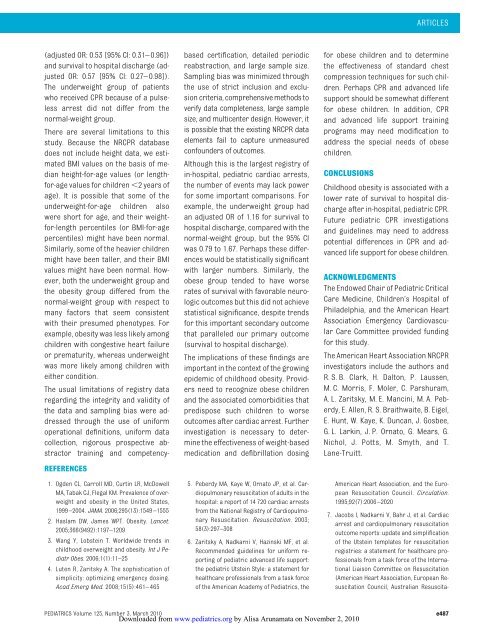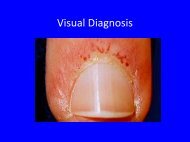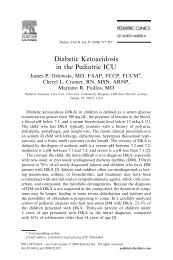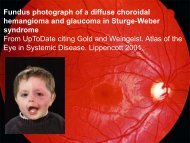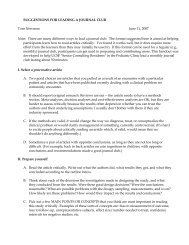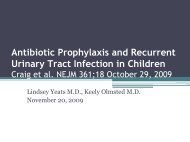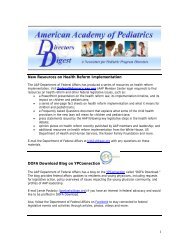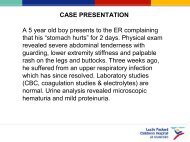DOI: 10.1542/peds.2009-1324 2010;125;e481-e488; originally ...
DOI: 10.1542/peds.2009-1324 2010;125;e481-e488; originally ...
DOI: 10.1542/peds.2009-1324 2010;125;e481-e488; originally ...
You also want an ePaper? Increase the reach of your titles
YUMPU automatically turns print PDFs into web optimized ePapers that Google loves.
(adjusted OR: 0.53 [95% CI: 0.31–0.96])<br />
and survival to hospital discharge (adjusted<br />
OR: 0.57 [95% CI: 0.27–0.98]).<br />
The underweight group of patients<br />
who received CPR because of a pulseless<br />
arrest did not differ from the<br />
normal-weight group.<br />
There are several limitations to this<br />
study. Because the NRCPR database<br />
does not include height data, we estimated<br />
BMI values on the basis of median<br />
height-for-age values (or lengthfor-age<br />
values for children 2 years of<br />
age). It is possible that some of the<br />
underweight-for-age children also<br />
were short for age, and their weightfor-length<br />
percentiles (or BMI-for-age<br />
percentiles) might have been normal.<br />
Similarly, some of the heavier children<br />
might have been taller, and their BMI<br />
values might have been normal. However,<br />
both the underweight group and<br />
the obesity group differed from the<br />
normal-weight group with respect to<br />
many factors that seem consistent<br />
with their presumed phenotypes. For<br />
example, obesity was less likely among<br />
children with congestive heart failure<br />
or prematurity, whereas underweight<br />
was more likely among children with<br />
either condition.<br />
The usual limitations of registry data<br />
regarding the integrity and validity of<br />
the data and sampling bias were addressed<br />
through the use of uniform<br />
operational definitions, uniform data<br />
collection, rigorous prospective abstractor<br />
training and competency-<br />
REFERENCES<br />
1. Ogden CL, Carroll MD, Curtin LR, McDowell<br />
MA, Tabak CJ, Flegal KM. Prevalence of overweight<br />
and obesity in the United States,<br />
1999–2004. JAMA. 2006;295(13):1549–1555<br />
2. Haslam DW, James WPT. Obesity. Lancet.<br />
2005;366(9492):1197–1209<br />
3. Wang Y, Lobstein T. Worldwide trends in<br />
childhood overweight and obesity. Int J Pediatr<br />
Obes. 2006;1(1):11–25<br />
4. Luten R, Zaritsky A. The sophistication of<br />
simplicity: optimizing emergency dosing.<br />
Acad Emerg Med. 2008;15(5):461–465<br />
based certification, detailed periodic<br />
reabstraction, and large sample size.<br />
Sampling bias was minimized through<br />
the use of strict inclusion and exclusion<br />
criteria, comprehensive methods to<br />
verify data completeness, large sample<br />
size, and multicenter design. However, it<br />
is possible that the existing NRCPR data<br />
elements fail to capture unmeasured<br />
confounders of outcomes.<br />
Although this is the largest registry of<br />
in-hospital, pediatric cardiac arrests,<br />
the number of events may lack power<br />
for some important comparisons. For<br />
example, the underweight group had<br />
an adjusted OR of 1.16 for survival to<br />
hospital discharge, compared with the<br />
normal-weight group, but the 95% CI<br />
was 0.79 to 1.67. Perhaps these differences<br />
would be statistically significant<br />
with larger numbers. Similarly, the<br />
obese group tended to have worse<br />
rates of survival with favorable neurologic<br />
outcomes but this did not achieve<br />
statistical significance, despite trends<br />
for this important secondary outcome<br />
that paralleled our primary outcome<br />
(survival to hospital discharge).<br />
The implications of these findings are<br />
important in the context of the growing<br />
epidemic of childhood obesity. Providers<br />
need to recognize obese children<br />
and the associated comorbidities that<br />
predispose such children to worse<br />
outcomes after cardiac arrest. Further<br />
investigation is necessary to determine<br />
the effectiveness of weight-based<br />
medication and defibrillation dosing<br />
5. Peberdy MA, Kaye W, Ornato JP, et al. Cardiopulmonary<br />
resuscitation of adults in the<br />
hospital: a report of 14 720 cardiac arrests<br />
from the National Registry of Cardiopulmonary<br />
Resuscitation. Resuscitation. 2003;<br />
58(3):297–308<br />
6. Zaritsky A, Nadkarni V, Hazinski MF, et al.<br />
Recommended guidelines for uniform reporting<br />
of pediatric advanced life support:<br />
the pediatric Utstein Style: a statement for<br />
healthcare professionals from a task force<br />
of the American Academy of Pediatrics, the<br />
ARTICLES<br />
for obese children and to determine<br />
the effectiveness of standard chest<br />
compression techniques for such children.<br />
Perhaps CPR and advanced life<br />
support should be somewhat different<br />
for obese children. In addition, CPR<br />
and advanced life support training<br />
programs may need modification to<br />
address the special needs of obese<br />
children.<br />
CONCLUSIONS<br />
Childhood obesity is associated with a<br />
lower rate of survival to hospital discharge<br />
after in-hospital, pediatric CPR.<br />
Future pediatric CPR investigations<br />
and guidelines may need to address<br />
potential differences in CPR and advanced<br />
life support for obese children.<br />
ACKNOWLEDGMENTS<br />
The Endowed Chair of Pediatric Critical<br />
Care Medicine, Children’s Hospital of<br />
Philadelphia, and the American Heart<br />
Association Emergency Cardiovascular<br />
Care Committee provided funding<br />
for this study.<br />
The American Heart Association NRCPR<br />
investigators include the authors and<br />
R. S. B. Clark, H. Dalton, P. Laussen,<br />
M. C. Morris, F. Moler, C. Parshuram,<br />
A. L. Zaritsky, M. E. Mancini, M. A. Peberdy,<br />
E. Allen, R. S. Braithwaite, B. Eigel,<br />
E. Hunt, W. Kaye, K. Duncan, J. Gosbee,<br />
G. L. Larkin, J. P. Ornato, G. Mears, G.<br />
Nichol, J. Potts, M. Smyth, and T.<br />
Lane-Truitt.<br />
American Heart Association, and the European<br />
Resuscitation Council. Circulation.<br />
1995;92(7):2006–2020<br />
7. Jacobs I, Nadkarni V, Bahr J, et al. Cardiac<br />
arrest and cardiopulmonary resuscitation<br />
outcome reports: update and simplification<br />
of the Utstein templates for resuscitation<br />
registries: a statement for healthcare professionals<br />
from a task force of the International<br />
Liaison Committee on Resuscitation<br />
(American Heart Association, European Resuscitation<br />
Council, Australian Resuscita-<br />
PEDIATRICS Volume <strong>125</strong>, Number 3, March <strong>2010</strong> e487<br />
Downloaded from<br />
www.pediatrics.org by Alisa Arunamata on November 2, <strong>2010</strong>


